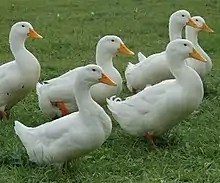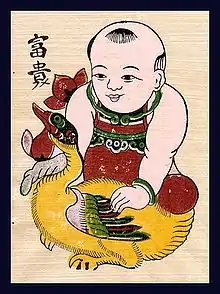Domestic duck
The domestic duck or domestic mallard (Anas platyrhynchos domesticus) is a subspecies of mallard that has been domesticated by humans and raised for meat, eggs, and down feathers. A few are also kept for show, as pets, or for their ornamental value. Almost all varieties of domesticated ducks, apart from the domestic Muscovy duck (Cairina moschata), are descended from the mallard.[1][2]
| Domestic duck | |
|---|---|
 | |
| Farm in Taiwan | |
Domesticated | |
| Scientific classification | |
| Domain: | Eukaryota |
| Kingdom: | Animalia |
| Phylum: | Chordata |
| Clade: | Dinosauria |
| Class: | Aves |
| Order: | Anseriformes |
| Family: | Anatidae |
| Genus: | Anas |
| Species: | |
| Subspecies: | A. p. domesticus |
| Trinomial name | |
| Anas platyrhynchos domesticus | |
Domestication
Whole-genome sequencing suggests that domestic ducks originate from a single domestication event of mallards during the Neolithic, followed by rapid selection for lineages favouring meat or egg production. They were probably domesticated in Southeast Asia – most probably in Southern China – by the rice paddy-farming ancestors of modern Southeast Asians, and spread outwards from that region. There are few archaeological records, so the date of domestication is unknown; the earliest written records are in Han Chinese writings from central China dating to about 500 BC. Duck farming for both meat and eggs is a widespread and ancient industry in Southeast Asia.[3]
Wild ducks were hunted extensively in Ancient Egypt and other parts of the world in ancient times, but were not domesticated. Ducks are documented in Ancient Rome from the second century BC, but descriptions – notably those of Columella – suggest that ducks in Roman agriculture were tamed, not domesticated; there was no duck breeding in Roman times, so eggs from wild ducks were needed to start duck farms.[4]
Most breeds and varieties of domestic duck derive from the mallard, Anas platyrhynchos; a few derive from Cairina moschata, the Muscovy duck, or are mulards, hybrids of these with A. anas stock.[5] Domestication has greatly altered their characteristics. Domestic ducks are mostly promiscuous, where wild mallards are monogamous. Domestic ducks have lost the mallard's territorial behaviour, and are less aggressive than mallards.[6][7] Despite these differences, domestic ducks frequently mate with wild mallards, producing fully fertile hybrid offspring.[8]
Farming
.jpg.webp)
Ducks have been farmed for thousands of years.[9] Domestic ducks are reared principally for meat, but also for duck eggs.[10]: 258 Some are used for production of foie gras de canard.[10]: 311 In some cultures the blood of ducks slaughtered for meat is used as food; it may be eaten seasoned and lightly cooked, as in Ireland,[11]: 392 or be used as an ingredient, as in a number of regional types of blood soup, among them the czarnina of Poland[12]: 299 and the tiết canh of Vietnam. Down and feathers are a by-product of duck farming.[13]
In 2021 approximately 4.3 billion ducks were slaughtered for meat worldwide, for a total yield of about 6.2 million tonnes;[14] over 80% of this production was in China, where more than 3.6 billion ducks were killed, yielding some 4.9 million tonnes of meat.[15] Worldwide production of duck meat was substantially lower than that of chicken – 73.8 billion birds slaughtered, 121.6 million tonnes – but considerably greater than that of geese – about 750 million birds killed for 4.4 million tonnes of meat.[14]
Ducks may lay some 200 eggs per year;[10]: 258 the eggs may be white or tinted blue or green. Demand for fresh duck eggs is fairly limited;[10]: 258 in many Asian countries, and particularly in the Philippines, balut – a fertilised duck egg at about 17 days of development, boiled and eaten with salt – is considered a delicacy and is sold as street food.[10]: 53

Domestic ducks are susceptible to infection with the dangerous H5N1 strain of avian influenza.[16]
The females of many breeds of domestic duck are unreliable at sitting their eggs and raising their young. Exceptions include the Rouen duck and especially the Muscovy duck. It has been a custom on farms for centuries to put duck eggs under broody hens for hatching; nowadays this role is often played by an incubator. However, young ducklings rely on their mothers for a supply of preen oil to make them waterproof; a chicken hen does not make as much preen oil as a female duck, and an incubator makes none. Once the duckling grows its own feathers, it produces preen oil from the sebaceous gland near the base of its tail.[17]
Ducks are also kept for their ornamental value. Breeds have been developed with crests and tufts or striking plumage, for exhibition in competitions.[18]
In culture

In children's stories
The domestic duck has appeared numerous times in children's stories. Beatrix Potter's The Tale of Jemima Puddle-Duck was published by Frederick Warne & Co in 1908. One of Potter's best-known books, the tale was included in the Royal Ballet's The Tales of Beatrix Potter.[19] It is the story of how Jemima, a domestic duck, is saved from a cunning fox who plans to kill her, when she tries to find a safe place for her eggs to hatch.[20]
Make Way for Ducklings is a children's picture book written and illustrated by Robert McCloskey. First published in 1941, the book tells the story of a pair of mallards who decide to raise their family on an island in the lagoon in Boston Public Garden, a park in the center of Boston. Make Way for Ducklings won the 1942 Caldecott Medal for McCloskey's illustrations.[21]
The Disney cartoon character Donald Duck, one of the world's most recognizable pop culture icons, is a domestic duck of the American Pekin breed.[22]
In music
The domestic duck features in the musical composition Peter and the Wolf, written by Sergei Prokofiev in 1936. The orchestra illustrates the children's story while the narrator tells it.[23] In this, a domestic duck and a little bird argue on each other's flight capabilities. The duck is represented by the oboe. The story ends with the wolf eating the duck alive, its quack heard from inside the wolf's belly.[24]
In art
Domestic ducks are frequently depicted in wall paintings and grave objects from ancient Egypt.[25] They are featured in a range of ancient artefacts, which revealed that they were a fertility symbol.[26]
As food
Since ancient times, the duck has been eaten as food.[27] Usually only the breast and thigh meat is eaten.[28] It does not need to be hung before preparation, and is often braised or roasted, sometimes flavoured with bitter orange or with port.[29] Peking duck is a dish of roast duck from Beijing, China, that has been prepared since medieval times. It is today traditionally served with spring pancakes, spring onions and sweet bean sauce.[30][31]
References
- "Anas platyrhynchos, Domestic Duck; DigiMorph Staff - The University of Texas at Austin". Digimorph.org. Retrieved 23 December 2012.
- Sy Montgomery. "Mallard; Encyclopædia Britannica". Britannica.com. Retrieved 23 December 2012.
- Zhang, Zebin; Jia, Yaxiong; Almeida, Pedro; Mank, Judith E; van Tuinen, Marcel; Wang, Qiong; Jiang, Zhihua; Chen, Yu; Zhan, Kai; Hou, Shuisheng; Zhou, Zhengkui; Li, Huifang; Yang, Fangxi; He, Yong; Ning, Zhonghua; Yang, Ning; Qu, Lujiang (1 April 2018). "Whole-genome resequencing reveals signatures of selection and timing of duck domestication". GigaScience. 7 (4). doi:10.1093/gigascience/giy027. PMC 6007426. PMID 29635409.
- Albarella, Umberto (2005). "Alternate fortunes? The role of domestic ducks and geese from Roman to Medieval times in Britain". In G., Grupe; J., Peters (eds.). Feathers, Grit and Symbolism: Birds and Humans in the Ancient Old and New Worlds (PDF). Documenta Archaeobiologiae III. Verlag Marie Leidorf. pp. 249–258. ISBN 9783896466181.
- Appleby, Michael C.; Mench, Joy A.; Hughes, Barry O. (2004). Poultry Behaviour and Welfare. CABI. ISBN 978-0-851-99667-7.
- Piggott, Stuart; Thirsk, Joan (February 1981). The Agrarian History of England and Wales: Volume 1, Part 1, Prehistory. Cambridge University Press Archive. ISBN 978-0-521-08741-4.
- DigiMorph Staff –The University of Texas at Austin (2004). "Anas platyrhynchos, Domestic Duck". Digimorph.org. Archived from the original on 27 November 2016. Retrieved 23 December 2012.
- Wood-Gush, D. (2012). Elements of Ethology: A textbook for agricultural and veterinary students. Springer. ISBN 978-9-400-95931-6.
- Kiple, Kenneth F.; Ornelas, Kriemhild Coneè (2000). The Cambridge World History of Food. Cambridge University Press. ISBN 978-0-521-40214-9. OCLC 44541840.
- Alan Davidson (1999). The Oxford Companion to Food. Oxford: Oxford University Press. ISBN 9780192115799.
- Darina Allen (2018). Irish Traditional Cooking. London: Kyle Books. ISBN 9780857836960.
- Jennifer McLagan (2017). Blood, Not So Simple. In: Mark McWilliams (editor) (2017). Offal: Rejected and Reclaimed Food: Proceedings of the 2016 Oxford Symposium on Food and Cookery. London: Prospect Books. ISBN 9781909248557.
- Duck and Goose from Farm to Table. Washington, DC: Food Safety and Inspection Service of the United States Department of Agriculture. Archived 20 September 2013.
- Production Crops Livestock E All Area Groups NOFLAG (large download). Rome: Food and Agriculture Organization of the United Nations. Accessed June 2023. Lines 323–330.
- Production Crops Livestock E All Data NOFLAG (large download). Rome: Food and Agriculture Organization of the United Nations. Accessed June 2023. Lines 10405–10406.
- Songserm, Thaweesak; Jam-on, Rungroj; Sae-Heng, Numdee; Meemak, Noppadol; Hulse-Post, Diane J.; Sturm-Ramirez, Katharine M.; Webster, Robert G. (April 2006). "Domestic Ducks and H5N1 Influenza Epidemic, Thailand". Emerging Infectious Diseases. 12 (4): 575–581. doi:10.3201/eid1204.051614. ISSN 1080-6040. PMC 3294714. PMID 16704804.
- "Ducks - Poultry Breeds Encyclopedia".
- "The best ducks to keep in your garden: in pictures". The Daily Telegraph. Retrieved 28 June 2017.
- Roberts, Laura (16 December 2010). "The Tales of Beatrix Potter performed by The Royal Ballet". Telegraph.co.uk. Archived from the original on 21 August 2016. Retrieved 26 June 2017.
- Potter, Beatrix (1993). Tale of Jemima Puddle-Duck. Frederick Warne. ISBN 9781854713858.
- "Randolph Caldecott Medal". American Library Association. 2021. Retrieved 27 June 2023.
- "Pekin Ducks". Oklahoma State University Extension - Department of Food & Animal Sciences. 20 July 2021. Retrieved 27 June 2023.
- Rijke, Victoria de (2008). Duck. Reaktion Books. ISBN 978-1-861-89489-2.
- Prokofiev, Sergei (1999). Peter and the Wolf. North-South Books. ISBN 978-0-735-81189-8.
- LeMaster, Richard (March 1995). The Great Gallery of Ducks and Other Waterfowl. Stackpole Books. ISBN 978-0-811-70706-0.
- Chadd, Rachel Warren; Taylor, Marianne (2016). Birds: Myth, Lore and Legend. Bloomsbury Publishing. ISBN 978-1-472-92287-8.
- Dalby, Andrew (2013). Food in the Ancient World from A to Z. Routledge. ISBN 978-1-135-95422-2.
- The Visual Food Encyclopedia. Québec Amerique. 1996. ISBN 978-2-764-40898-8.
- Davidson, Alan (2006). The Oxford Companion to Food. Oxford University Press. p. 472. ISBN 978-0-191-01825-1.
- "The Evolution of Peking Duck". CBS. 24 September 2006.
- "A Cultural Classic: Peking Duck". Globe Trekker. Archived from the original on 17 May 2012. Retrieved 26 June 2017.
